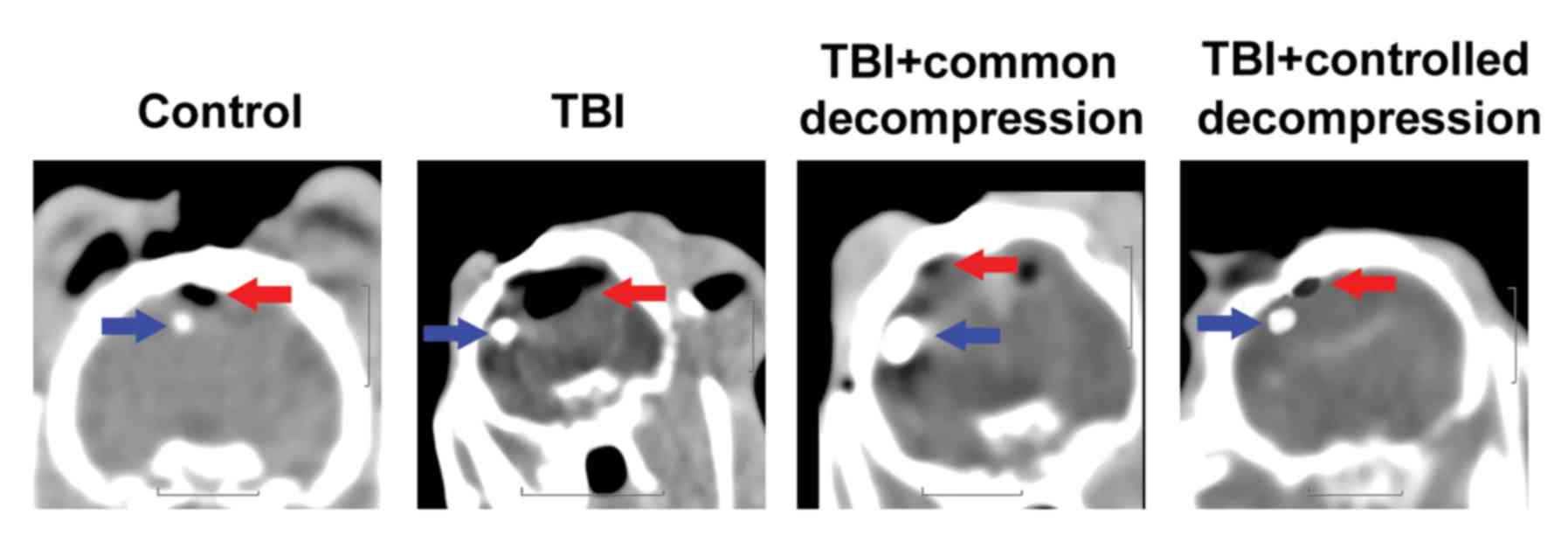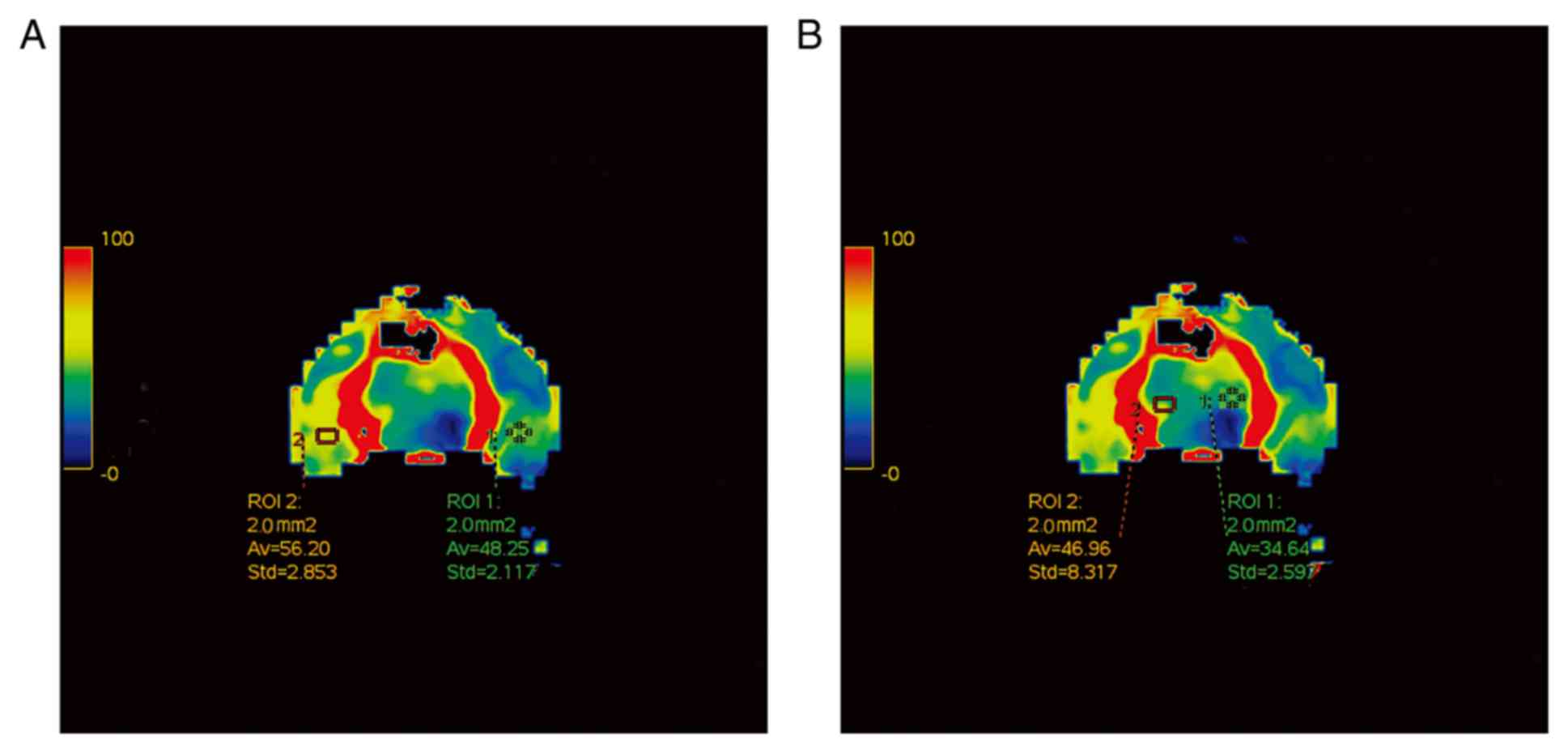|
1
|
Iaccarino C, Carretta A, Nicolosi F and
Morselli C: Epidemiology of severe traumatic brain injury. J
Neurosurg Sci. 62:535–541. 2018.PubMed/NCBI
|
|
2
|
Blennow K, Brody DL, Kochanek PM, Levin H,
McKee A, Ribbers GM, Yaffe K and Zetterberg H: Traumatic brain
injuries. Nat Rev Dis Primers. 2:160842016. View Article : Google Scholar : PubMed/NCBI
|
|
3
|
Teasdale G, Murray G, Parker L and Jennett
B: Adding up the glasgow coma score. Acta Neurochir Suppl (Wien).
28:13–16. 1979.PubMed/NCBI
|
|
4
|
Jiang JY; Chinese Head Trauma Study
Collaborators: Head trauma in China, : Injury. 44:1453–1457. 2013.
View Article : Google Scholar : PubMed/NCBI
|
|
5
|
Oddo M, Levine JM, Mackenzie L, Frangos S,
Feihl F, Kasner SE, Katsnelson M, Pukenas B, Macmurtrie E,
Maloney-Wilensky E, et al: Brain hypoxia is associated with
short-term outcome after severe traumatic brain injury
independently of intracranial hypertension and low cerebral
perfusion pressure. Neurosurgery. 69:1037–1045. 2011.PubMed/NCBI
|
|
6
|
Farahvar A, Gerber LM, Chiu YL, Härtl R,
Froelich M, Carney N and Ghajar J: Response to intracranial
hypertension treatment as a predictor of death in patients with
severe traumatic brain injury. J Neurosurg. 114:1471–1478. 2011.
View Article : Google Scholar : PubMed/NCBI
|
|
7
|
Kaloostian P, Robertson C, Gopinath SP,
Stippler M, King CC, Qualls C, Yonas H and Nemoto EM: Outcome
prediction within twelve hours after severe traumatic brain injury
by quantitative cerebral blood flow. J Neurotrauma. 29:727–734.
2012. View Article : Google Scholar : PubMed/NCBI
|
|
8
|
Rostami E, Engquist H and Enblad P:
Imaging of cerebral blood flow in patients with severe traumatic
brain injury in the neurointensive care. Front Neurol. 5:1142014.
View Article : Google Scholar : PubMed/NCBI
|
|
9
|
Lim D, Lee SH, Kim DH, Choi DS, Hong HP,
Kang C, Jeong JH, Kim SC and Kang TS: The possibility of
application of spiral brain computed tomography to traumatic brain
injury. Am J Emerg Med. 32:1051–1054. 2014. View Article : Google Scholar : PubMed/NCBI
|
|
10
|
Servadei F, Nasi MT, Giuliani G, Cremonini
AM, Cenni P, Zappi D and Taylor GS: CT prognostic factors in acute
subdural haematomas: The value of the ‘worst’ CT scan. Br J
Neurosurg. 14:110–116. 2000. View Article : Google Scholar : PubMed/NCBI
|
|
11
|
Douglas DB, Chaudhari R, Zhao JM, Gullo J,
Kirkland J, Douglas PK, Wolin E, Walroth J and Wintermark M:
Perfusion imaging in acute traumatic brain injury. Neuroimaging
Clin N Am. 28:55–65. 2018. View Article : Google Scholar : PubMed/NCBI
|
|
12
|
Bendinelli C, Bivard A, Nebauer S, Parsons
MW and Balogh ZJ: Brain CT perfusion provides additional useful
information in severe traumatic brain injury. Injury. 44:1208–1212.
2013. View Article : Google Scholar : PubMed/NCBI
|
|
13
|
Brazinova A, Mauritz W, Leitgeb J,
Wilbacher I, Majdan M, Janciak I and Rusnak M: Outcomes of patients
with severe traumatic brain injury who have Glasgow Coma Scale
scores of 3 or 4 and are over 65 years old. J Neurotrauma.
27:1549–1555. 2010. View Article : Google Scholar : PubMed/NCBI
|
|
14
|
Bell RS, Mossop CM, Dirks MS, Stephens FL,
Mulligan L, Ecker R, Neal CJ, Kumar A, Tigno T and Armonda RA:
Early decompressive craniectomy for severe penetrating and closed
head injury during wartime. Neurosurg Focus. 28:E12010. View Article : Google Scholar : PubMed/NCBI
|
|
15
|
Gouello G, Hamel O, Asehnoune K, Bord E,
Robert R and Buffenoir K: Study of the long-term results of
decompressive craniectomy after severe traumatic brain injury based
on a series of 60 consecutive cases. ScientificWorldJournal.
2014:2075852014. View Article : Google Scholar : PubMed/NCBI
|
|
16
|
Charry JD, Rubiano AM, Nikas CV, Ortíz JC,
Puyana JC, Carney N and Adelson PD: Results of early cranial
decompression as an initial approach for damage control therapy in
severe traumatic brain injury in a hospital with limited resources.
J Neurosci Rural Pract. 7:7–12. 2016. View Article : Google Scholar : PubMed/NCBI
|
|
17
|
Quintard H, Lebourdon X, Staccini P and
Ichai C: Decompression surgery for severe traumatic brain injury
(TBI): A long-term, single-centre experience. Anaesth Crit Care
Pain Med. 34:79–82. 2015. View Article : Google Scholar : PubMed/NCBI
|
|
18
|
Chen WL, Yang LK and Kuang H:
Establishment of posttraumatic acute diffuse brain swelling with
sinus balloon compression method in rabbits. Chin J Trauma.
8:753–757. 2015.
|
|
19
|
Gungormus M and Kaya O: Evaluation of the
effect of heterologous type I collagen on healing of bone defects.
J Oral Maxillofac Surg. 60:541–545. 2002. View Article : Google Scholar : PubMed/NCBI
|
|
20
|
Bragin DE, Statom GL, Yonas H, Dai X and
Nemoto EM: Critical cerebral perfusion pressure at high
intracranial pressure measured by induced cerebrovascular and
intracranial pressure reactivity. Crit Care Med. 42:2582–2590.
2014. View Article : Google Scholar : PubMed/NCBI
|
|
21
|
Yan LZ, Sheng LY and Bing C: Changes of
the transcranial Doppler spectrum wave form in the model of acute
intracranial hypertension in rabbits. Bulletin Hunan Medical Univ.
27:441–444. 2002.
|
|
22
|
Donnelly J, Czosnyka M, Harland S, Varsos
GV, Cardim D, Robba C, Liu X, Ainslie PN and Smielewski P: Cerebral
haemodynamics during experimental intracranial hypertension. J
Cereb Blood Flow Metab. 37:694–705. 2017. View Article : Google Scholar : PubMed/NCBI
|
|
23
|
Honda M, Ichibayashi R, Yokomuro H,
Yoshihara K, Masuda H, Haga D, Seiki Y, Kudoh C and Kishi T: Early
cerebral circulation disturbance in patients suffering from severe
traumatic brain injury (TBI): A Xenon CT and perfusion CT study.
Neurol Med Chir (Tokyo). 56:501–509. 2016. View Article : Google Scholar : PubMed/NCBI
|
|
24
|
Pan J, Zhang J, Huang W, Cheng X, Ling Y,
Dong Q and Geng D: Value of perfusion computed tomography in acute
ischemic stroke: Diagnosis of infarct core and penumbra. J Comput
Assist Tomogr. 37:645–649. 2013. View Article : Google Scholar : PubMed/NCBI
|
|
25
|
Thierfelder KM, Sommer WH, Baumann AB,
Klotz E, Meinel FG, Strobl FF, Nikolaou K, Reiser MF and von
Baumgarten L: Whole-brain CT perfusion: Reliability and
reproducibility of volumetric perfusion deficit assessment in
patients with acute ischemic stroke. Neuroradiology. 55:827–835.
2013. View Article : Google Scholar : PubMed/NCBI
|
|
26
|
Powers WJ, Grubb RL Jr and Raichle ME:
Physiological responses to focal cerebral ischemia in humans. Ann
Neurol. 16:546–552. 1984. View Article : Google Scholar : PubMed/NCBI
|
|
27
|
Barthelemy EJ, Melis M, Gordon E, Ullman
JS and Germano IM: Decompressive craniectomy for severe traumatic
brain injury: A systematic review. World Neurosurg. 88:411–420.
2016. View Article : Google Scholar : PubMed/NCBI
|
|
28
|
Cooper DJ, Rosenfeld JV, Murray L, Arabi
YM, Davies AR, D'Urso P, Kossmann T, Ponsford J, Seppelt I, Reilly
P, et al: Decompressive craniectomy in diffuse traumatic brain
injury. N Engl J Med. 364:1493–1502. 2011. View Article : Google Scholar : PubMed/NCBI
|
|
29
|
Wang Y, Wang C, Yang L, Cai S, Cai X, Dong
J, Zhang J and Zhu J: Controlled decompression for the treatment of
severe head injury: A preliminary study. Turk Neurosurg.
24:214–220. 2014.PubMed/NCBI
|
|
30
|
Toth P, Szarka N, Farkas E, Ezer E,
Czeiter E, Amrein K, Ungvari Z, Hartings JA, Buki A and Koller A:
Traumatic brain injury-induced autoregulatory dysfunction and
spreading depression-related neurovascular uncoupling:
Pathomechanisms, perspectives, and therapeutic implications. Am J
Physiol Heart Circ Physiol. 311:H1118–H1131. 2016. View Article : Google Scholar : PubMed/NCBI
|
|
31
|
Moretti R, Pansiot J, Bettati D,
Strazielle N, Ghersi-Egea JF, Damante G, Fleiss B, Titomanlio L and
Gressens P: Blood-brain barrier dysfunction in disorders of the
developing brain. Frontiers Neuroscience. 9:402015. View Article : Google Scholar
|













